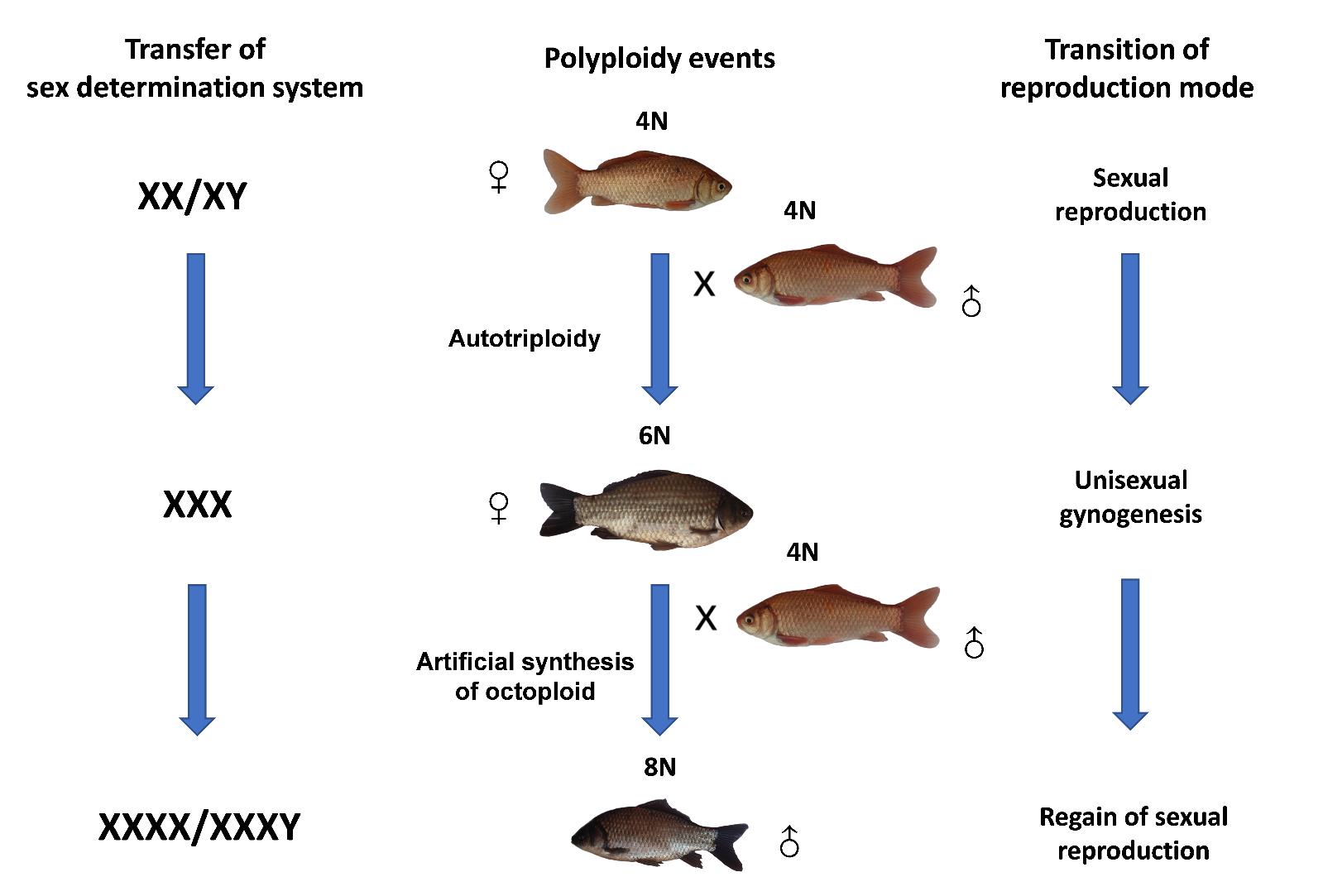Highlights
Researchers Discover Regain of Sex Determination System and Sexual Reproduction Ability in Synthetic Octoploid Male Fish
Polyploidy plays a significant role in the evolution and speciation of diverse organisms. Compared with the prevalence in plants, polyploid species are very rare in vertebrates. Polyploids in vertebrates are generally associated with unisexual reproduction. However, how polyploids pass through the reproduction bottleneck via unisexual reproduction modes, and how their sex determination system transfer and reproduction modes transform remain unclear.
Polyploid Carassius species complex consists of tetraploid Carassius auratus with sexual reproduction and hexaploid Carassius gibelio with unisexual gynogenesis. Early studies also have found out that C. gibelio has the capability to form higher ploidy allopolyploids by incorporating heterogenous genome. Thus, the extant Carassius lineage with diverse ploidy levels is a unique case to investigate the transition of unisexual/sexual reproduction mode and transfer of sex determine system in response to polyploidy.
Over the past five years, the research group led by Prof. GUI Jian-Fang (CAS member) from Institute of Hydrobiology (IHB) of Chinese Academy of Sciences synthesized a group of artificial octoploids by incorporating sperm of tetraploid C. auratus with sexual reproduction ability into the eggs of gynogenetic hexaploid C. gibelio.
These synthetic octoploids contained over 200 chromosomes, 50 of which were from C. auratus. Importantly, the X/Y sex chromosomes and sex determination system from sexual tetraploid C. auratus were also incorporated, which lead to the 1:1 sex ratio in synthetic octoploids.
They found out that a few synthetic octoploid males have restored fertility, and one synthetic octoploid male was discovered to completely regain the ability of sexual reproduction, which exhibited similar characteristics to the sexual reproductive tetraploid males. These characteristics include meiosis completion, euploid sperm formation in spermatogenesis, normal embryonic development when mated with tetraploid females, and similar transcriptional profiles during embryogenesis.
More importantly, when the tetraploid female mated with the synthetic octoploid male, these embryos generated to be a novel group of synthetic hexaploids, whose sex ratio was near 1:1 and sex chromosome composition were♀XXX /♂XXY.
This study was published online in the journal SCIENCE CHINA Life Sciences with the title of “Regain of sex determination system and sexual reproduction ability in a synthetic octoploid male fish”.
It not only provides a unique case to explore the transfer of sex determination system and transition of reproduction modes in response to polyploidy in vertebrates, but also provides theoretical and technological support to polyploid breeding of C. gibelio.
This work was supported by the National Natural Science Foundation of China, the Strategic Priority Research Program of the CAS and other projects.

Transfer of sex determination system and transition of reproduction mode along with polyploidy in Carassius species. 4N, tetraploid C. auratus; 6N, hexaploid C. gibelio; 8N, synthetic octoploid; ♀, female; ♂, male. (Image by IHB)
Contact:
Prof. GUI Jianfang
Research Group of Fish Developmental Genetics and Cell Engineering
Institute of Hydrobiology, Chinese Academy of Sciences
E-mail: jfgui@ihb.ac.cn